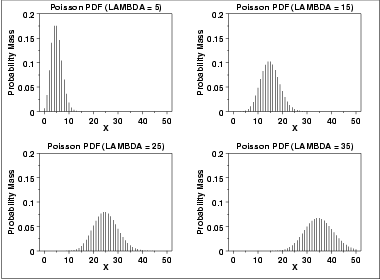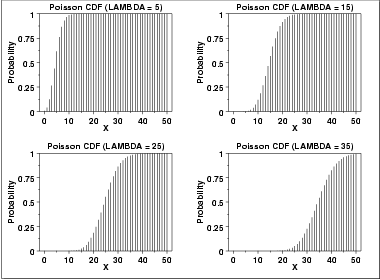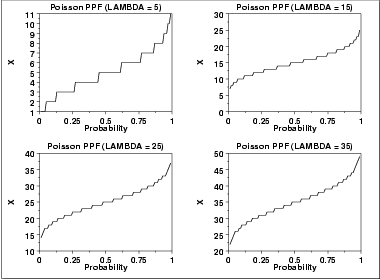| |||||||||||||||
| Probability Mass Function | The Poisson distribution is used to model the number of events occurring within a given time interval.The formula for the Poisson probability mass function is  is the shape parameter which indicates the average number of events in the given time interval. is the shape parameter which indicates the average number of events in the given time interval.The following is the plot of the Poisson probability density function for four values of  . . | ||||||||||||||
| Cumulative Distribution Function | The formula for the Poisson cumulative probability function is![F(x,lambda) = SUM[EXP(-lambda)*lambda**i/i!]
where the summation is for i = 0 to x](http://www.itl.nist.gov/div898/handbook/eda/section3/eqns/poicdf.gif) The following is the plot of the Poisson cumulative distribution function with the same values of  as the pdf plots above. as the pdf plots above. | ||||||||||||||
| Percent Point Function | The Poisson percent point function does not exist in simple closed form. It is computed numerically. Note that because this is a discrete distribution that is only defined for integer values of x, the percent point function is not smooth in the way the percent point function typically is for a continuous distribution.The following is the plot of the Poisson percent point function with the same values of  as the pdf plots above. as the pdf plots above. | ||||||||||||||
| Common Statistics |
| ||||||||||||||
| Parameter Estimation | The maximum likelihood estimator of  is is where  is the sample mean. is the sample mean. | ||||||||||||||
| Software | Most general purpose statistical software programs support at least some of the probability functions for the Poisson distribution. | ||||||||||||||
Runs Test for Detecting Non-randomness Purpose: Detect Non-Randomness The runs test ( Bradley, 1968 ) can be used to decide if a data set is from a random process. A run is defined as a series of increasing values or a series of decreasing values. The number of increasing, or decreasing, values is the length of the run. In a random data set, the probability that the ( I +1)th value is larger or smaller than the I th value follows a binomial distribution , which forms the basis of the runs test. Typical Analysis and Test Statistics The first step in the runs test is to count the number of runs in the data sequence. There are several ways to define runs in the literature, however, in all cases the formulation must produce a dichotomous sequence of values. For example, a series of 20 coin tosses might produce the f...


Comments
Post a Comment